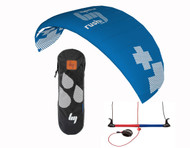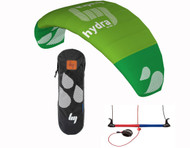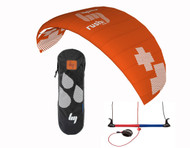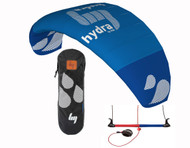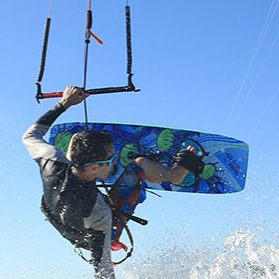
I'm new! I'm looking for a trainer kite...
I'm looking for a beginner, entry-level power kite for...
I'm looking for a board...
- Home
- Kiteboard
- Learning Center
- Kitemare Lessons Learned

Categories
Brands
Current Top Sellers
-
$279.00

-
$389.99$379.99
-
$349.99

-
$439.99$435.45
-
$348.50$345.50
Kitemare Lessons Learned

Kiteboarding Dangers, Accident Reports and Lessons Learned
Contact Us to Share your Kitemare Story to Help Others Avoid Their Own Kitemare!
One of the main reasons we're here is to help people from experiencing their own kitemare experiences. We want to redefine kitemare to something good (yes, we're the good guys) and not a bad memory that resulted from a bad decision or from inexperience, or just plain bad luck. (If we can minimize the first two, then the luck part shouldn't play as high of a role ;)
Minimize the Risk
This page is NOT here to scare you away from the sport. But, We want you to be aware of the risks involved with Kite Sports and to learn from the experiences of others.
Think about what the rider could have done to prevent or minimize the risk. All sports have risks. Skiing, Mtn Biking, Climbing, Motorcross, Surfing, Rock-climbing, and yes.. Kiteboarding as well.
For those people thinking..."I don't need a lesson, I'll just buy some cheap gear and figure it out myself" ...this page (not a Budweiser) is FOR YOU!
When you head for the beach, imagine doing everything right. Imagine arriving home, feeling great, and being stoked about another amazingly fun kiting session.
Focus on what you WANT to happen on the water. Focus on safety, respect of others, new friends, new adventures, and having another outstanding day participating in the sport you love. In short...
"Learn fast, Kite Safe, get Amped, go Huge, and Share the Stoke!"
Kitesurfer Should Have Released Disaster.
Location: South Africa
Kiter: Daniel Lehmann
Wind: Very strong, Approximately 25 knots
Kite: 11m Cabrinha
Well if you'd like to add the following lessons that I learned from the whole experience that would be great:
"At the time of this accident I was still very much a novice kitesurfer.
Although I had taken one or two lessons in the past, I was not familiar enough with the emergency procedures. I also was definitely not experienced enough to attempt flying an 11 square metre bow kite in upwards of 25 knots of gusty inland wind.
I should have practiced my emergency procedures to commit them to muscle memory and to figure out where my priorities lay. I did not take enough time to realise that replacing a kite is far cheaper than surgery to reconstruct a crushed vertebra. Instead, I tried in vain to save my kite when I should have ejected early on in the whole series of unfortunate events. I hope that this video helps other budding kitesurfers to realise the value of reliable and safe training and that it is better to lose your kite than to lose your life.
..."The worst part is that I actually did know how to eject the kite but I was not FAMILIAR enough with it for it to be a natural reaction in that very quick moment when it all went wrong.
That's the importance of practice until something becomes muscle memory. It's all well and good to know your procedures when you're methodically thinking about them; a completely different story in the heat of the moment" ... Stay safe and happy kiting!"
Thanks.
Center-line wrapped around the bar
The video directly below is a PERFECT example of why kiteboarding lessons are needed.
The MOST important part of lessons is learning about the safety aspects,
including a good understanding of how the safety systems work and what to do
when you have a malfunction. Having a plan-A, and plan-B, and C.
Carry a Hook-Knife. Replacing cut lines is much less expensive than a trip to
the emergency room. Obviously a Pre-flight check is essential.
Wind Speed - Even a Small Trainer kite "can" be dangerous
Hi, I want to share my story, because I feel it's really important as I was just a beginner and wish I knew what I knew now.
My brother and I had been practicing power kiting with a 2.8 meter kite.
We had gone out at least ten times or more in winds around 13-20 knots.
Just one month ago on November 23rd, the wind was blowing really well around 20-25 knots. So we went to our usual spot and started to fly the kite in large figure eights and was feeling kind of over powered. I had a feeling I should stop as the pull was feeling too strong, We weren't trying any tight kite loops. Then on one pass from high right 90 degrees to 45 degrees center the kite pulled me in a strong gust so hard I flew about 10 feet and landed with my arms straight out, doing a face plant and flip. I immediately knew I had dislocated my shoulder, because I couldn't feel my arm anymore or move it.
I got my brother to lift it straight up and it went back into place easily. The bad news is it popped out again one hour later and also one week later with almost no movement. Even after wearing a sling for a week. Over the month I saw many doctors and they all say my shoulder is unstable that I can't work out, do sports or any over head lifting until I get surgery.
I got an MRI and one doctor still couldn't tell me if anything was torn in my shoulder such as the labrum or rotator cuff. So now I am waiting to see the surgeon with the MRI images. The worst part I was one month away from going to Dominican Republic to try real kiteboarding for one month. I am still going thankfully, but not kiting. Really bad timing and stupid accident.
Lesson, even a training kite can be dangerous in 20-25 knot winds, if you are steering it quickly. Never fly a training kite in winds greater than 20 knots. I think it says on the manufactures warning not to fly above 20 knots also. My mistake. The accident happened so quickly there was no chance to let go of the bar, I was already off the ground and back down in 1-3 seconds. Always kite with another person, because if you are injured in a remote area it could save your health or life. Also a dislocated shoulder is not a simple injury and can happen more easily than people think. When the bone comes out it stretches ligaments and the capsule, they never return to normal. Causing for more dislocations and need for surgery.
Recommendation, always sit down when piloting a training kite, if it does pull you will mostly drag across the ground instead of jumping with the kite. If you get pulled over sitting, or pulled to standing and almost falling over then stop immediately. Make sure the stopper ball on the safety leash is not stopping the kite from depowering. The ball on this kite was stopping the middle line from going any further than three feet. Even when I hit the ground, and let go of the bar, the kite and safety leash dragged me another 5 feet. Meaning even if I had let go of the bar in time before, the safety leash would have pulled my other arm out.
Thanks, Paul Bradley Age: 29
"If you ever "have the feeling you should stop" or feel that the conditions are beyond your comfort zone, or your skill level... Then STOP!!!
That feeling that he should stop, was ignored, and you read the result.
Listen to your gut feeling, it's highly. intelligent.
"Unable to release the bar". Yes, it can happen. The way to prevent it, is to...
Physically practice releasing the control bar so that it becomes part of your muscle memory.
Knowing what to do, is NOT the same as an instant reaction from physical practice. Wind Speed limit? 20 Knots? It's not a bad rule of thumb, but it depends on your weight, your kite size, your skills and abilities, etc. Progress gradually,and if you're uncomfortable then stop. We wish Paul a 100% recovery.
Fly with Care -Kailua, Hawaii Shattered Femur
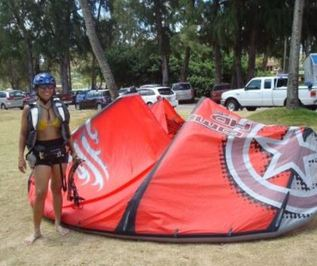

My name is Annamarie Love. I live in Hawaii. I'm 46 years old, 114 lbs, and began kiting 6 months ago (respectively). I am able to get up for a bit on a light wind day 10-12mph (12 meter Contra/ 135 lab rat board). No turning capabilities yet.
On July 9, 2010, as I was coming in to the beach in Kailua, HI, instead of bringing my kite to the neutral position and walk up the beach, I pulled too hard to the right (in fear of my kite landing in the trees), and my kite got caught in the power-zone. Nevertheless, I was lifted 20 feet and slammed back down in the shallow water. The kite continued to pull me down the beach, so I emergency released my gear.
Since I landed in a standing position on my left leg, I shattered my Femur, Tibula, and disconnected my Meniscus. I have pins, plates and bone graphs holding my knee together.
Lesson- Fly your kite with care, it doesn't take much to turn it. Also be aware of the wind conditions. Pay attention to the gusts...
And that's my kitemare....
Aloha,
Annamarie
Drift Launching gone wrong in the Florida. Lines slice into fingers
June 10th, 2012 Geiger beach , Big coppitt key. Near Key West.
With no one to go with I've been self launching the kite by drift launching it. The first few times went fine but I tried it as the winds were 18-20 knots and after I had the lines off the bar I noticed I big tangle 10 feet up past the bar. I let the bar float and went up to untangle it and as I'm doing this a big gust came in and picked the kite right up even though I had the front lines tight in my hand and the back lines slack. I tried to hang on to the front lines hoping the kite would come down but instead the lines sliced into four of my fingers before I had a chance to let go. I then stepped back just in time to dodge the bar as it came whizzing by at head level. The kite then flew 50 or so feet in the air and a few 100 feet downwind before landing on the beach and doing a few rolls up to a barb wire fence. Luckily I was able to run over and grab the kite before it decided to take flight again into the fence. The only damage was to my fingers and my pride as 2 kiters that were already there had seen the whole thing. That was about a month ago and my fingers are still healing. Luckily they didn't get stuck in the tangle or I may have lost a few digits. Not sure if this is a kitemare or not but it definitely taught me to respect the kite and certainly to not try things past my skill level such as self launching.
Thanks again!
Captain Seth Hopp
Onshore Winds, with Tiny Buffer Zone and Large Boulders
June 29th, 2010 Mammoth Lakes, California
"This kitemare occurred at Grant Lake in the June Lakes / Mammoth Lakes area of the Eastern Sierra's. I kiteboard in the Eastern Sierra, where the wind is notoriously gusty. Usually it tends to be on the light side at the accessible kiting lakes around here: Crowley, June, and Grant. However, even so, the wind can gust surprisingly high, even on a light day. It was late in the afternoon, and when my kiteboarding buddy and I arrived at Grant Lake, the wind was very light, approximately 13 to 18 mph, averaging around 15 mph. The water level was very high, which meant some of the gravely beaches where I might otherwise have started from were underwater. This left very few options for launching points. Using larger kites, his a 14m, mine a 15m hybrid, we launched from a gravely beach in a cove, where the wind was blowing onshore with a bit of an angle into the cove. To get out into the lake involved making a first reach nearly parallel to the shore, and then clearing some boulders a bit off of the shore. My buddy, who is both much more experienced and lighter than I took out his surfboard, strapless, and was able to clear the rocks just fine. As for me, I'm 190 lbs in weight. Not being as experienced with a strapless surfboard and recognizing the sketchiness of the launch, I opted for my twintip. I figured in those winds even if I could not make it around the rocky section, I'd be able to veer back into the beach section at the last moment and it would still be safe due to the light winds. I was about 5 or 10 minutes behind my buddy in setting everything up and launching my kite. My first couple of attempts to get going I just ended up back at the beach. The third attempt I ended up a bit among the rocks -- that should have been a dire warning for me. Walking back around the cove and upwind was taking some time, during which the wind conditions were drastically changing, (After the incident, my meter was showing upper 20's with a peak of 34 mph!) Furthermore, walking around the cove I neared an embankment, and I was afraid of being lofted -- another clue.
So I started out, got planing and edging, and had a good line going -- at that point it seemed I was going to clear the rocks just fine. A spectator even mentioned afterward that it had looked as if I would make it. Unfortunately as I approached the rocks, the wind first seemed to momentarily lull, causing me to go downwind and heading straight for the large boulder I had intended to clear. At this point I should have pulled my quick release -- actually I should never have been out there at all! However, instead I figured maybe I could just go around the downwind side of the boulder and still get around the point into the open water. By the way, everyone should be aware that turning the board downwind inevitably causes the kite to drift downwind and power up, right? Now at this point, the wind suddenly started to heave and surge, and I no longer had clean consistent power. I cleared the downwind side of the boulder, but could not hold on to my new line. Looking downwind I realized I would be pulled straight into another boulder (sticking up about a foot above the water-line). I put out my kiteboard straight out in front of me and braced for the impact. I am not sure whether I pulled the quick release just before that impact, upon impact, or just after impact. Somehow I knew I would be okay with that first impact, and it was flipping over and landing onto whatever was beyond it that could have been really really bad, and much worse than fortunately it turned out to be. I don't know, but I'm going to guess I was accelerating to around 20-25 mph at this point. So approaching the boulder I tried to brace and absorb as much energy as I could. It was, BAM! and the next instant I was flipping over the other side, completely disoriented and just trying to get my body in a position for the second impact. Everything happened so fast. I found myself in about a foot of water with rocks all around. I stood up as fast as I could, hoping that the quick-release had worked and the kite was not about to continue with me again. Fortunately it was on the ground, with a 3-foot long rip and bladder blowout along the leading edge, in the sage brush, and not going anywhere. Just to be sure I disconnected my leash. I was not knocked out, nor did I hit my head -- it was more a feeling of being disoriented for a moment and trying to determine my injury status. I felt quite fortunate to be standing, with no broken bones. All I could do is look down shake my head. I did not go into kiting thinking I would do anything stupid, yet here I was. In collecting myself the thought crossed my mind that I was a fool to have ever gotten into this sport in the first place. As a side-note, my buddy, finding himself way over-powered, had decided to pull his quick release and drift in.
It took a couple of hours for the pain to really kick in. I write this the following day afterward, sitting around at home completely useless. I have 3 areas of injury: #1 A banged up left hip and muscle pain when I try to move my left leg. #2 Pain in my right ankle joint or calcaneous (from impact, not a sprain). #3 Pain in my left posterior rib area and pain when moving certain ways or taking deep breaths. This later pain made it difficult to lie down and sleep last night. After some time of sheer misery I found it necessary to pile up several pillows to angle my upper body in order to sleep, which needed to be on my back. Standing and walking is slow and painful and I wish I had one of those walkers old people use. Just getting around my apartment to get a drink of water or go to the bathroom is a chore. (That said, wide-mouthed containers can make life a whole lot easier for a guy!) Getting up from bed was very painful -- I try to be strategic about it to minimize motions and pressures that will hurt. This morning I had to be careful not to pass out. I cannot emphasize enough how lucky I was. It could have been a whole lot worse -- I could have broken my neck, compressed vertebrae, etc. Had it been just a little worse I may well be an inpatient at the hospital right now. I do feelsomeone above was watching out for me that day.
Lessons Learned: #1 Always leave a large safety buffer downwind. Don't even think of starting in an area where there is not a sufficient buffer zone, particularly where there are rocks. #2 Don't get in the mindset of "I think I can." Instead think about what can go wrong -- especially considering sudden gusts and lulls that can take you by surprise. #3 Pay attention to changing conditions and be willing to pull the plug (even though you took all that time and effort to set up and are ready to go.) #4 Listen to that little voice in your head -- if it feels unsafe, don't go. #5 As soon as your buffer zone is compromised beyond what you initially intended, pull the quick release NOW rather than try to keep going and attempt a different way around. If it gets worse, then you have absolutely no buffer zone at all and you're screwed. #6 Just because your kiteboarding buddy can do it does not mean you can.
In summary through my eagerness and desire for an epic kiteboarding session I could have killed pr paralyzed myself -- a very sobering thought. Absolutely no kiteboarding session is worth that."
- David Lee June 29, 2010
So you want to buy a Board Leash?
Posted on Kiteforum Sat Nov 21, 2009 4:09 am
Subject: Cured of the Board Leash....

"Pictures are worth a 1000 or so the saying goes. This happened today in about 20 knots in pretty choppy surf. I am a beginner and got a leash so I would spend less time retrieving my board and more time on it. I was wearing a helmet and the leash was a long real leash made for kiting not a surfers board leash. Lets face it
I'm lucky that all I got was 13 stitches and a trip to the ER. This had the potential to be life changing or ending."
"Pretty much a beginners wipeout. Wave caught the board as I was trying to build up speed after a water start. As I came up out of the water to regain my footing that is when the board caught up with. I have come to realize what everyone was saying about how dangerous they where. I wish that I could have heard about a story like mine to have understand just how bad it could be to me but a slingshot kiteboard catapulting past you could end up hurting someone else as well. I'm not going to say anyone should or should not use them that is their choice to make. Just think it is good to share what can actually happen. I can replace a lost or damaged board I can't replace my head."
Trainer-Kite and the result of a monkey-grip.
November 7th 2009 Kite: 3.5m Trainer , Wind: 18 mph+
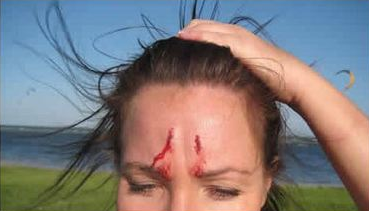 "...took my kite out today and bashed my face and body so hard into the ground that I knock the wind right out of me. I have 2 one inch long bloody gashes in the middle of my forehead (my face looks ridiculous now), I think I bruised my lungs or ribs and my right hand and wrist is swollen and hurts. The worst part is that I don't know how it happened. I've taken the kite out 3 time before and did fine. However the winds were 8 to 10.."
"...took my kite out today and bashed my face and body so hard into the ground that I knock the wind right out of me. I have 2 one inch long bloody gashes in the middle of my forehead (my face looks ridiculous now), I think I bruised my lungs or ribs and my right hand and wrist is swollen and hurts. The worst part is that I don't know how it happened. I've taken the kite out 3 time before and did fine. However the winds were 8 to 10.."
"...Now I know why they call them "power" kites. Your description was probably what happened because I only hurt one hand. I think it was the hand that didn't let go fast enough. The wrist strap was connected to my other hand. It happened so fast that I don't even think I could have let go fast enough. I am going to practice letting go of the bar 10 times a day everyday now..."
"I've attached a picture of my forehead that got smashed into the ground. It doesn't look that bad but it hurts ten times worse than it looks"
( As far as we can tell, she was hit by a strong gust, and release with only one hand. Having only one hand remaining on the bar caused the kite to turn a tight circle and probably loop. Whether it was just one large power sweep, or a full loop, the little 3.5m still pulled hard enough to cause injuries.
Remember:: When releasing the bar, release both hands at the same time.
Practice dropping the control bar on the ground several times so that it will become automatic.)
"Hi Jeff, I don't mind if you use my emails and photo. Just don't forget to mention that I may have a fractured wrist and ribs along with bashing my head. I wouldn't wish that on anyone.Thanks for all the advice. I'm definitely shooting for light to moderate winds next time."
Professional Kiteboarder Dimitri Soaring over Stiltsville
Board-Leash disabled ability to depower. August 15th, 2008
" Hi Jeff, I’ve only recently taken up kiteboarding - tried to do all the right things (bought a trainer kite, had lessons etc, always get assistance when launching/landing etc etc) but still managed to end up doing something very stupid a few weeks ago that could have ended up a lot worse than it did.
I was practicing my waterstarts with a large board which had a surfboard style leash attached to it. I had been tempted to take it off as I’ve heard of nasty leash related accidents, but was assured by many people that it would be good to leave it on until I got the starts cracked. The kite came down after a failed attempt at getting on the board, and whilst I was trying to relaunch it – the board drifted through the lines and went behind me just as the kite powered up and took off. Before I knew what had happened, the kite was looping like crazy dragging me backwards through the water. I released the chicken loop which made no difference, so I then released the safety leash too – not realising it was the board leash that was connecting me to the kite (wrapped around the bar) so I had a fully powered kite, with no depower looping like a demon – with no way of cutting the board leash! I ended up getting dragged through about 200meters of surf, then 50yds up a beach when the kite finally impaled itself on a fence post and stopped. Lessons learned: · Don’t use a board leash without a QR system (especially the surfboard kind) · When connected in this way, releasing the chicken loop and kite leash was the worst thing to do – as I couldn’t depower the kite or reach any of the lines once I’d done this. · Once I’d recovered and calmed down, I realised that my harness had a QR on the suicide connector (which is what the board leash was connected to) – releasing this would have instantly got rid of the kite.
Best regards, Ian from Scotland
The above email from Ian is loaded with valuable lessons. Here's our view:
His only big mistake was listening to people who suggested to use a board leash with a kite. Never use any type of board leash ( when using a kite ), unless you understand the high risk and feel that value of your board is higher than the value of your life. Board leashes combined with a kites power are a bad idea Know your gear, know all of your safety options, and what do in case of an emergency. We're glad to hear that Ian escaped without any serious injury and appreciate his contribution to this website and other kiters.
Leg caught in run-away kite. from Marcos in Spain
I was looking through your website reading the kitemares and have realized that no one has submitted anything new for a long time. I think kitemares are the best way to learn. So here is something that happened to me a couple of weeks ago (big rookie mistake). First of all I am an experienced sailor (every type of sailing boat), surfer and getting pretty good at kiteboarding. Well, the other day I rigged my brand new 12m Best HP Nemesis (COOLEST KITE ever) with about 20 knots wind and went to self launch. The only problem is that where I usually kite in the south of Spain can be extremely gusty. I burried one wing tip and start making my way back to the bar. All of a sudden I feel one of those gusts (27 knts) so I turn around just in time to see my kite launch without me. The only thing that I could think was that this brand new kite is not taking off without me. So I leaped on top of the bar......BAD IDEA. Not only did I not grab the bar but managed to get my leg caught on it making the kite turn into a very fast kiteloop. To the horror of my poor mom who had just arrived to the beach, she saw her son leap into the air by his leg and then dragged over 50 meters through a rocky beach only to stop/crash against a lifeguard house. The result of this shitty bad call was no skin left on chest and back, bruised ribcage, busted shoulder and a broken kite!! Lesson learned was...
LET GO OF THE BLOODY KITE, ITS NOT WORTH IT.
The sad thing is that before that I had told a lot of friends, who were starting to kite, the kite is worth nothing compared to the rider. Practice letting go of the kite!! KEEP KITING BUT BE SAFE!
KiteMare.com Comments
Leaving your Kites safety Leash attached to its proper place on the bar. (Steel ring on the chicken-loop, or one of the safety grab handles). In the situation of a kite trying to escape, Grap the end of the kite leash, or the chicken-loop, but NOT the bar. This will stop the kite from getting away and also de-power the kite at the same time.
Warm-Up, Stretch, and Be Careful
Jan 20, '06 11:02 PM Alex Korakis Tampa, FL Ruptured Tendon
The follow incident happened to a good friend of mine. Alex Korakis
Alex is an accomplished Surfer, Windsurfer, Sailor and Kiteboarder,.
Here is a copy of the email I received from him:
"Jeffrey what’s up?! Hope you're havin fun in Brazil.
Well looks like that Master got schooled. I have to say I never had a kitemare until now, and it’s gonna be a bit of a haul. After four doctors, all recommend surgery for get this –
A Rupture of my Pectoralis Major Tendon – From the MRI’s they believe about 80% of my tendon has snapped. If I skip surgery I risk not being able to reconnect it later, so I’ll be in surgery on Wednesday, Jan 25th. Without the Pectoralis muscle there is little to no internal rotation of your arm and the side of the rupture causing you to have an inverted chest. Gotta be fixed. After 27 years of Extreme Windsurfing and 3 years Kiteboarding and no major injuries until now here are the latest lessons learned:
1) Don’t get out of shape – You may know a move well but you’re muscle’s and tendons shrink when not used constantly and may be unable to handle even a usual blow
2) Always stretch at least a little before you begin
3) Before you try any big moves make sure your muscles are warmed up enough to take a blow. Meaning go back and forth for at least 10 minutes before you start rippin hard.
Basically what happened to me was I was not warmed up and my muscle did not stretch enough so the Tendon pulled right off the bone.
4) One of the differences between kiteboarding and windsurfing is sometime when coming down from a jump on a kiteboard it’s instinctive to put one hand down behind you as if to break your fall. This can easily tear your pectoral tendon and also your bicep tendons (bi – meaning two). Normally pectoralis tears are from No. 1 Body builders trying to bench press too much, No. 2 Waterskiing, and I’m guessing you will see more in kiteboarding as the sport grows. Note: That even the 20-25 year olds are at risk of this.
A few lessons from the past that kept me injury free until now:
1) If you have not been working out or kiteboarding regularly pick a flat water spot when the wind is no more than moderate for 4 or 5 sessions before you push the limit. Why – If you’re muscle’s are not built up your joints will be absorbing the impact of bouncing across the chop/waves and thus is where most the damage is from.
2) High jumps are also not good if you’re muscle’s are not built up enough to absorb the impact, and this will destroy your joints. The list goes on and on these tips are just a few general for protecting your body from unnecessary injury.
Conclusion: Now I face General anesthesia which means they put you under and open up my arm, they then cut the remaining approx 20% of tendon, inject my muscle’s with a muscle relaxer so can be stretched, drill a hole in the bone where the tendon used to be connected and anchor the tendon to the bone. The tendon then splices together with the bone over a period of time in which my arm is immobilized for a period of 6 weeks. Once I’m finished with that I must go through 5 months of rehab to re-strengthen the arm and stretch the tendon w/o popping it off again.
The cost is approx. $20,000.00 which fortunately I have good health insurance or it would be even more painful. Jeffrey – You rock!! Talk to you soon - Alex"
Jan 21st. 2nd email from Alex: Electric Air Pump? Just say No.
I’ve seen many people with electric pumps to inflate their kites. I never bothered purchasing one, I’ve always felt manually inflating the kite is a good warm up.
On the day of the injury I was feeling lazy and a guy standing next to me had just finished pumping up his kite with an electric pump, he offered it to me so I figured why not I’ll give it a try.
My injury occurred on my 2nd gibe, had I pumped up my kite manually my muscles may have been warmed up enough to stretch instead of snap. I would recommend a manual pump, as it gives you at least a little warm up to your muscles so they can stretch if your body needs to over extend for a maneuver.
(Note: that was the first and last time I will use and electronic pump – Ironic isn’t it!?" Alex
 Loading... Please wait...
Loading... Please wait...



